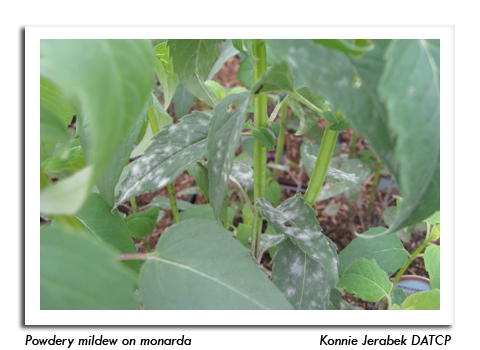
 |
|
|
Nursery & Forest
Volume 58 Number 5 Date 05/30/2013 CEDAR-APPLE RUST - Mature galls on juniper have recently begun sporulating in southern Wisconsin. The bright orange, gelatinous tendrils that emerge from these galls release spores which can infect apples and related fruit trees 2-3 miles away. Cedar-apple rust alternates between junipers and rosaceous plants and requires both hosts to complete its life cycle. Removal of the galls before sporulation is recommended to limit spread of the disease to the alternate hosts, apple, crabapple, hawthorn, quince, pear and serviceberry. POWDERY MILDEW - This common fungal disease of ornamental plants was observed on echinacea 'Flame Thrower' in a Waukesha County nursery. Powdery mildew appears on most plants as a grayish-white powdery growth on the upper leaves, which later causes the foliage to turn yellow and prematurely senesce. Reducing humidity levels and increasing air circulation will alleviate the problem. Fungicidal control is usually not necessary. VIRUSES - Nursery inspectors continue to find a variety of plants infected with viruses in Wisconsin greenhouses and garden centers. Cucumber mosaic virus (CMV) and tobacco rattle virus (TRV) remain the most common, but others such as impatiens necrotic spot virus (INSV) on Lychnis x arkwrightii 'Vesuvius' have also been detected. The increasing prevalence of viruses in the nursery trade emphasizes the need for proper sanitation of pruning tools since viruses can be spread mechanically by contaminated tools. Some viruses are also spread by nematodes, but control of the nematodes is usually impractical. Recognition of virus symptoms is critical for both nursery operators and gardeners who should avoid selling and purchasing infected plants. Plants with viral diseases cannot be treated to eliminate the virus and must be removed and disposed of by burning, burying or composting. LEAFCURL APHID - Snowball viburnums in a Waupaca County nursery were infested with these green aphids, which feed in clusters at the tips of the branches, causing twisting and curling of leaves. Aphid feeding usually results in little or no permanent damage, but control may be required for high populations. Insecticidal soaps and horticultural oils are effective if sprayed directly onto the foliage and aphids at temperatures below 85 °F (repeat applications at 5- to 7-day intervals may be required). Soil-applied systemic insecticides last longer and are the recommended form of control. -- Liz Meils, DATCP Nursery Inspector EARLY CONE FORMATION - Frasier firs in the northwest region of the state are responding to last summer's extreme heat and drought stress by producing early cones. These cones should be removed now, while they can be easily picked by hand. After mid-June, the bases of the cones will turn woody and removal will be more labor intensive. Premature coning is an undesirable trait in Fraser fir. -- Konnie Jerabek, DATCP Nursery Inspector 




|
|
|